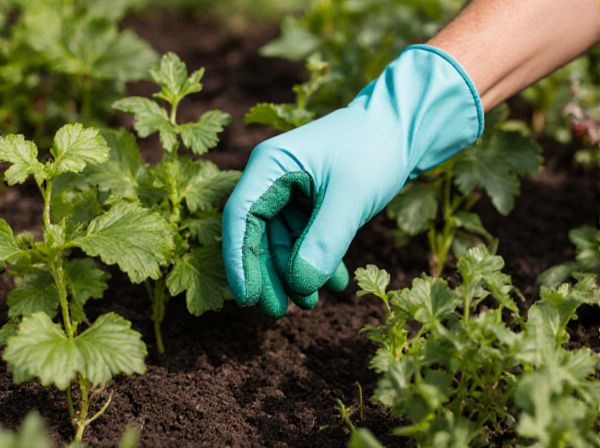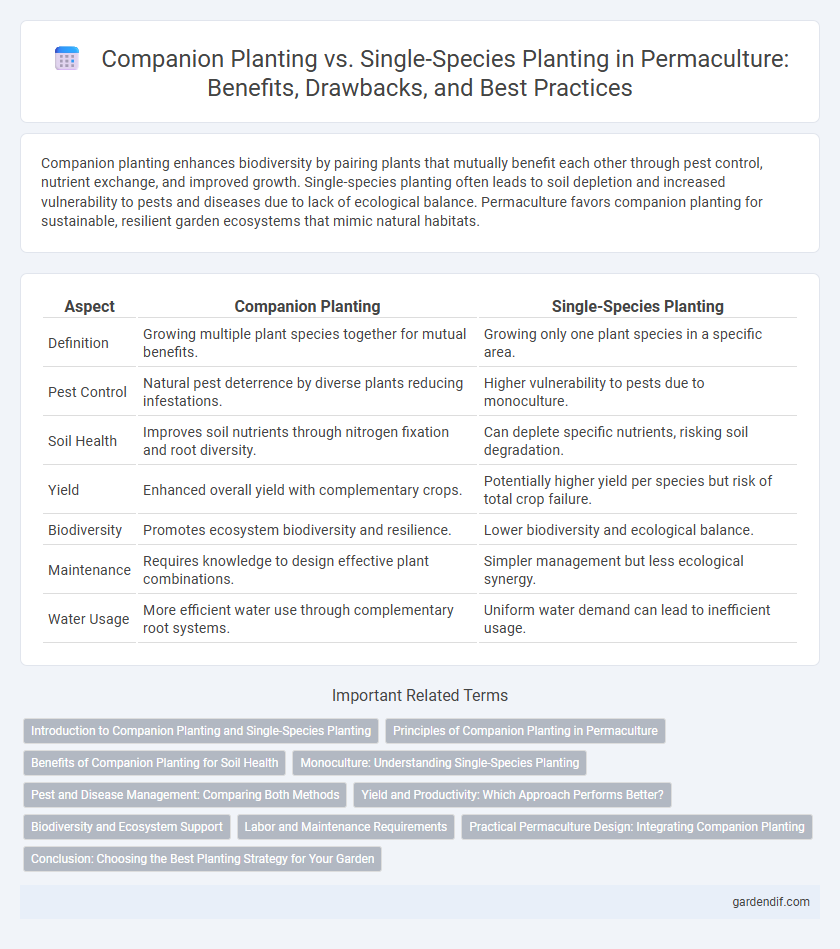
companion planting vs single-species planting Illustration
Companion planting enhances biodiversity by pairing plants that mutually benefit each other through pest control, nutrient exchange, and improved growth. Single-species planting often leads to soil depletion and increased vulnerability to pests and diseases due to lack of ecological balance. Permaculture favors companion planting for sustainable, resilient garden ecosystems that mimic natural habitats.
Table of Comparison
| Aspect | Companion Planting | Single-Species Planting |
|---|---|---|
| Definition | Growing multiple plant species together for mutual benefits. | Growing only one plant species in a specific area. |
| Pest Control | Natural pest deterrence by diverse plants reducing infestations. | Higher vulnerability to pests due to monoculture. |
| Soil Health | Improves soil nutrients through nitrogen fixation and root diversity. | Can deplete specific nutrients, risking soil degradation. |
| Yield | Enhanced overall yield with complementary crops. | Potentially higher yield per species but risk of total crop failure. |
| Biodiversity | Promotes ecosystem biodiversity and resilience. | Lower biodiversity and ecological balance. |
| Maintenance | Requires knowledge to design effective plant combinations. | Simpler management but less ecological synergy. |
| Water Usage | More efficient water use through complementary root systems. | Uniform water demand can lead to inefficient usage. |
Introduction to Companion Planting and Single-Species Planting
Companion planting enhances biodiversity by pairing plants that mutually benefit each other through pest control, nutrient exchange, and improved growth, promoting ecological balance in permaculture systems. Single-species planting, or monoculture, simplifies management but often leads to nutrient depletion and increased vulnerability to pests and diseases. Integrating companion planting strategies optimizes soil health and crop yields, contributing to sustainable agricultural practices.
Principles of Companion Planting in Permaculture
Companion planting in permaculture enhances biodiversity by cultivating diverse plant species together, promoting natural pest control and improving soil health through nutrient exchange and nitrogen fixation. Strategic pairing of plants like legumes with heavy feeders reduces the need for synthetic fertilizers, fostering sustainable and resilient ecosystems. This method optimizes space and resource use, increasing overall productivity compared to single-species monoculture systems.
Benefits of Companion Planting for Soil Health
Companion planting enhances soil health by promoting biodiversity, which improves nutrient cycling and supports beneficial microorganisms like mycorrhizal fungi and nitrogen-fixing bacteria. Diverse root structures and plant residues contribute organic matter, boosting soil structure and moisture retention while reducing erosion. This method also naturally suppresses pests and diseases, minimizing the need for chemical inputs that can degrade soil quality.
Monoculture: Understanding Single-Species Planting
Monoculture refers to the agricultural practice of growing a single species or crop in a specific area, often leading to reduced biodiversity and increased vulnerability to pests and diseases. This method can simplify management and harvesting but may deplete soil nutrients and necessitate higher chemical inputs for pest control. In contrast, permaculture emphasizes diverse companion planting to create resilient ecosystems that enhance soil health and reduce the need for synthetic interventions.
Pest and Disease Management: Comparing Both Methods
Companion planting enhances pest and disease management by promoting biodiversity, attracting beneficial insects, and naturally repelling harmful pests through strategic plant pairings like marigolds with tomatoes. Single-species planting often creates monocultures that increase vulnerability to pests and diseases due to uniform host availability and lack of natural predators. Integrating diverse plant species in permaculture systems reduces reliance on chemical pesticides, improving ecosystem resilience and crop health.
Yield and Productivity: Which Approach Performs Better?
Companion planting enhances yield and productivity by promoting biodiversity, natural pest control, and improved soil health, resulting in higher overall crop output compared to single-species planting. Polyculture systems in permaculture benefit from complementary plant interactions that increase resource use efficiency and resilience against environmental stresses. Single-species planting often faces risks like soil nutrient depletion and pest outbreaks, which can reduce long-term productivity despite potentially higher initial yields.
Biodiversity and Ecosystem Support
Companion planting enhances biodiversity by integrating multiple plant species that support each other's growth, improving pest control and soil health through natural processes. Single-species planting reduces biodiversity, often leading to increased vulnerability to pests and diseases while depleting specific soil nutrients. Diverse plant interactions in permaculture systems create resilient ecosystems, promoting long-term sustainability and ecosystem support.
Labor and Maintenance Requirements
Companion planting reduces labor and maintenance requirements by promoting natural pest control, improving soil health, and enhancing crop resilience through biodiversity, which decreases the need for frequent interventions. Single-species planting often demands intensive labor for pest management, soil amendments, and maintenance due to lack of ecological balance and increased vulnerability. Efficient labor allocation in companion planting results from synergistic plant relationships that minimize repetitive tasks and maximize resource utilization.
Practical Permaculture Design: Integrating Companion Planting
Companion planting enhances soil health, pest control, and crop yields by integrating diverse plant species that mutually support each other's growth, essential in practical permaculture design. Single-species planting often leads to nutrient depletion and increased vulnerability to pests, contrasting the ecological balance achieved through companion planting. Effective permaculture systems utilize strategic plant combinations to optimize space, resources, and biodiversity, promoting sustainable and resilient agricultural practices.
Conclusion: Choosing the Best Planting Strategy for Your Garden
Companion planting enhances biodiversity, improves soil health, and reduces pest problems by leveraging natural plant relationships, making it ideal for sustainable garden ecosystems. Single-species planting simplifies management and maximizes yield for crops requiring uniform conditions but often increases vulnerability to pests and soil depletion. Selecting the optimal planting strategy depends on garden goals, space, and ecological factors, with permaculture principles favoring diverse, integrated planting systems for long-term resilience.
companion planting vs single-species planting Infographic

 gardendif.com
gardendif.com